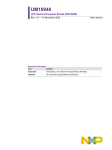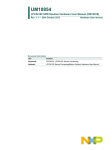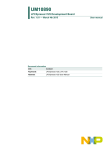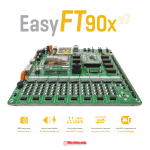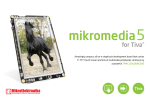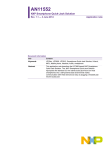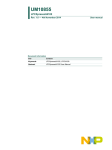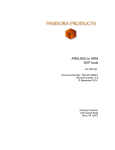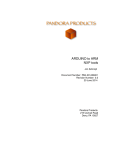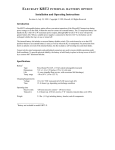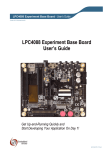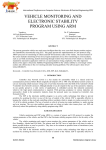Download UM10940 - LPCware.com!
Transcript
UM10940 LPC General Purpose Shield (OM13082) Rev. 1.0 — 20th October 2015 Document information Info Content Keywords LPCXpresso, LPC General Purpose Shield, OM13082 Abstract LPC General Purpose Shield User Manual User manual UM10940 NXP Semiconductors LPC General Purpose Shield (OM13082) Revision history Rev Date Description 1.0 OM13082 User Manual release <20151910> Contact information For more information, please visit: http://www.nxp.com For sales office addresses, please send an email to: [email protected] UM10940_OM1382.docm User manual All information provided in this document is subject to legal disclaimers. Rev. 1.0 — 20th October 2015 © NXP B.V. 2015. All rights reserved. 2 of 14 UM10940 NXP Semiconductors LPC General Purpose Shield (OM13082) 1. Introduction The LPC General Purpose Shield Board has been designed to complement NXP’s range of LPCXpresso MCU development boards by providing easy access to several commonly used peripherals. The LPC General Purpose Shield plugs into the top-side expansion connectors of LPCXpresso V2, V3, and MAX boards. The LPC General Purpose Shield connectors have the standard Arduino UNO R3 pins plus the additional expansion connections available on LPCXpresso V3 boards. LPCXpresso V2 and MAX boards may still be used with the LPC General Purpose Shield but not all features of the Shield will be available. LPCXpresso™ is a low-cost development platform available from NXP, supporting NXP's ARM-based microcontrollers. The platform is comprised of an Eclipse-based IDE and low-cost target boards which include an on-board debugger. LPCXpresso is an end-toend solution enabling embedded engineers to develop their applications from initial evaluation to final production. This document describes the LPC General Purpose Shield (“LPC GP Shield”) hardware. 2. Feature summary The LPC GP Shield includes the following features: 128 x 64 LCD dot matrix display connected via SPI 4 user LEDs and 5 position joystick, controlled via an NXP PCA9535BS I²C port expander NXP LM75ADP temperature sensor connected via I²C Bosch BMI160 inertial measurement unit (3-axis accelerometer and 3-axis gyroscope, I²C) Potentiometer Features requiring LPCXpresso V3 board: o SD/MMC card slot o Ethernet RJ45 connector o CAN terminal block o Micro AB USB device connector 2.1 Board layout and settings This section provides a quick reference guide to the main board components, configurable items, visual indicators and expansion connectors. The LPC GP Shield board layout is shown in Fig 1. NOTE: The BMI160 IMU sensor, High speed CAN transceiver chip and NXP PCA9535BS I²C port expander are below the LCD display. To view them, gently push in the LCD stands from the back of the shield board; however it is not recommended to do this unless absolutely needed in order to avoid damage to the board. UM10940_OM1382.docm User manual All information provided in this document is subject to legal disclaimers. Rev. 1.0 — 20th October 2015 © NXP B.V. 2015. All rights reserved. 3 of 14 UM10940 NXP Semiconductors LPC General Purpose Shield (OM13082) User LEDs Fig 1. Board layout (top view) UM10940_OM1382.docm User manual All information provided in this document is subject to legal disclaimers. Rev. 1.0 — 20th October 2015 © NXP B.V. 2015. All rights reserved. 4 of 14 UM10940 NXP Semiconductors LPC General Purpose Shield (OM13082) 3. Getting Started 3.1 Compatibility with LPCXpresso boards The LPC GP Shield can be mounted on any LPCXpresso V2, V3 or MAX board. However, since LPCXpresso V2 and MAX boards do not have the extended expansion connectors available on the LPCXpresso V3 board, some features are not physically connected and cannot be used. Features used by the LPC GP Shield that are not available on V2 and MAX boards are: - CAN - USB - Ethernet - SD card The LPCXpresso board used may also not include the on-chip peripherals required to support some of the features of the LPC GP Shield; please refer to the manual for your LPCXpresso board and/or the target MCU for further information. Although the LPC GP Shield does not use all the signals available on the expansion connector, it is built with connectors to mate with all connections. This is to allow access to the signals from the LPCXpresso from the top of the shield for debug purposes. 3.2 Supporting Software As mentioned earlier in this Section, the LPC GP Shield can be used with most boards that have Arduino UNO R3-style connectors, and at least one of I2C, SPI, and/or analog inputs. NXP provides drivers and example code for the LPC GP Shield in its LPCOpen packages for the LPCXpresso boards shown below. To download these examples please visit http://www.lpcware.com/lpcopen. For the most up to date list of boards with LPCOpen example support for the LPC GP Shield please visit http://www.lpcware.com/lpcxpressoboards. - LPCXpresso1837 & LPCXpresso18S37 - LPCXpresso 4337 & LPCXpresso43S37 3.3 Board installation and removal There is only one orientation in which the Shield board can be correctly mounted on an LPCXpresso board; this is shown in Fig 2. The Shield and LPCXpresso boards are static sensitive boards, so take appropriate precautions to avoid ESD damage while assembling and using them. Carefully align the pins of the LPC GP Shield with the receptacles on the LPCXpresso board then apply even pressure with one thumb pressing between CN7 and CN9 and the other thumb pressing between CN6 and CN8. 3.4 Board revisions Boards from revision B onward include a FET placed in-line with the VDD connection to the SD/MMC card slot (see Section 4.7). Revision B and later boards have revision printed on the silkscreen on the underside of the board near the board name; revision A boards do not have the revision shown. UM10940_OM1382.docm User manual All information provided in this document is subject to legal disclaimers. Rev. 1.0 — 20th October 2015 © NXP B.V. 2015. All rights reserved. 5 of 14 UM10940 NXP Semiconductors LPC General Purpose Shield (OM13082) Fig 2. Installing the Shield on an LPCXpresso board (LPCXpresso4337 shown) Note: The last 4 pins, marked by the red square in the figure, are not required for operation of the shield and may be missing on your LPCXpresso board. To remove the shield gently pry up each corner in turn, a few millimeters at a time, repeating until the shield lifts away completely. 3.5 Powering the board When mounted onto any other LPCXpresso V2, V3, or MAX boards, there should be no need to power the board separately as power is supplied to the Shield through the extension connectors. However, when an SD card module such as a Wifi card is being used, or if the USB connector (CN1) is being used as a USB host, then it may be necessary to supply additional power by connecting a USB power supply to connector CN11 (on the underside of the Shield). When applying power to CN11 be sure to remove JP1 to disconnect the supply from the LPCXpresso board. Refer to Section 4.10 for more information on using CN1 as a USB host connection. UM10940_OM1382.docm User manual All information provided in this document is subject to legal disclaimers. Rev. 1.0 — 20th October 2015 © NXP B.V. 2015. All rights reserved. 6 of 14 UM10940 NXP Semiconductors LPC General Purpose Shield (OM13082) 4. Hardware Functionality and Peripherals The various available peripherals on the LPC GP Shield are described in this Section. The LPCXpresso V3 standard expansion connectors allow for two standard I 2C busses and multiple SPI chip selects so that the LPC GP Shield can be used with other shields mounted underneath it. Fig 3 shows the location of the signals used by the LPC GP Shield. (1) Fig 3. Expansion Connector signal locations 4.1 I2C Devices bus selection I2C connectivity is available from CN6 (standard Arduino location, labelled I2C1) or CN8 (LPCXpresso V3 boards only, labelled I2C2). Jumper JP6 can be used to select between these I2C ports, with I2C1 being the default. All devices on the LPC GP Shield that use I2C share the same bus. UM10940_OM1382.docm User manual All information provided in this document is subject to legal disclaimers. Rev. 1.0 — 20th October 2015 © NXP B.V. 2015. All rights reserved. 7 of 14 UM10940 NXP Semiconductors LPC General Purpose Shield (OM13082) 4.2 LCD display The 128x64 pixel LCD display module incorporates a Sitronix ST7565S controller. The LCD is controlled via the standard Arduino SPI connections (on connector CN6). One of 3 SPI chip selects can be used with the display, using jumper JP2. CS is the standard Arduino chip select (default), while CS0 and CS1 are LPCXpresso V3 signals available at CN9. Note that the LPCOpen drivers/examples (if available for your LPCXpresso board) include the basic SWIM graphics library, so direct programming of the Sitronix controller is not normally required. 4.3 LEDs and Joystick 4 user LEDs and a 5 position joystick (left, right, up, down and push) are provided on the LPC GP Shield. These devices are controlled over the selected I2C bus (see Section 4.1) by the NXP PCA9535BS, which provides 16 bits of general purpose parallel input/output (GPIO). The connection of this circuit is shown in Fig 4. For more information on the Port Expander please visit http://www.nxp.com/products/interface_and_connectivity/i2c/i2c_general_purpose_i_o/P CA9535BS.html. Fig 4. I2C Expander connections to LEDs and Joystick 4.4 Temperature Sensor The temperature sensor is interfaced via I2C bus. To get more information about this sensor please visit: http://www.nxp.com/products/interface_and_connectivity/i2c/i2c_temperature_voltage_m onitors/LM75ADP.html UM10940_OM1382.docm User manual All information provided in this document is subject to legal disclaimers. Rev. 1.0 — 20th October 2015 © NXP B.V. 2015. All rights reserved. 8 of 14 UM10940 NXP Semiconductors LPC General Purpose Shield (OM13082) 4.5 Bosch BMI160 Inertial Measurement Unit The Bosch BMI160 IMU is a highly integrated, low power inertial measurement unit (IMU). It provides precise acceleration and angular rate (gyroscopic) measurement. This sensor is interfaced to the LPCXpresso host MCU via I2C. For further information please visit Bosch Sensortec’s website (http://www.bosch-sensortec.com/) 4.6 Potentiometer A 10K trimming potentiometer, connected between ground and VCC is provided on the shield board to provide stimulus to the analog inputs of the host MCU on the LPCXpresso board onto which the Shield is mounted. The potentiometer wiper, can be routed to any or all of the A3, A4 and A5 connections on CN9 using JP7. Be sure to remove the connection to A5 if that pin is being used to control the USB host power enable. 4.7 SD/MMC card slot CN3 is a socket for an SD or a Multimedia Card, suitable for use with memory cards or select WiFi adapters such as the Gainspan GS2100M SDIO Wi-Fi Adapter Board. When using a wireless card such as the GS2100M mentioned above it may be necessary to supply extra power use the extra micro-B USB connector, CN11 (see Section 3.5). On revision B and later boards there is a FET placed in-line with the VDD connection to the SD/MMC card slot. This enables the power to this peripheral to be controlled using a GPIO connection from pin 1 of CN8 LPC GP Shield. 4.8 Ethernet RJ45 connector The onboard isolation transformer (TS8121CRJ45) and RJ45 connector (CN5) provide Ethernet connectivity via a category 5 cable. To use this connection the LPCXpresso board must include an Ethernet PHY. 4.9 CAN terminal block The CAN terminal block (CN2) gives a convenient option to connect with other systems via CAN bus. There is an on-board CAN transceiver chip (TJA1040) that provides an interface between the Controller Area Network (CAN) protocol controller and the physical bus. 4.10 USB connector CN1 is a micro-AB type USB connector, and thus can be configured to act for use with the LPCXpresso and LPC GP Shield system as a USB host or device. When configured as a host, the Shield needs to supply power to the connected USB device. The currentlimited power-distribution switch (TPS2041B) allows the shield to drive power from the base board to the device, with this switch having an active low enable control input. There are two possible sources for this enable control, configured using JP5. In the default jumper position, the control signal is sourced from A5 on CN9, with the alternative being pin 7 from CN9. If no jumpers are fitted on JP5 then the power switch is disabled (because there is a pull up resistor its enable), thus setting up the shield to acts as a USB device. If the jumper position is changed, it gets connected to the INT pin. This gives user the option to control the switch via software. UM10940_OM1382.docm User manual All information provided in this document is subject to legal disclaimers. Rev. 1.0 — 20th October 2015 © NXP B.V. 2015. All rights reserved. 9 of 14 UM10940 NXP Semiconductors LPC General Purpose Shield (OM13082) 4.11 Jumper settings The table below shows the available jumper configurations and their default settings. Circuit ref Description Default setting JP1 Connects power from LPCXpresso board to LPC GP shield. Remove when using power supplied from CN1 or CN11. See Section 4.10. Fitted JP2 Selects SPI chip select for the LCD display. See Section 4.2. CS (pins 5 & 6) JP3 Connects SD card detect signal to pin 18 of CN6. JP3 is a solder jumper, located immediately above the LCD. Fitted JP5 Selects between A5 and INT (pin 7 and pin 12 on connector) CN9 as active low source for CN1 USB power switch enable. Can be removed if CN1 is not used as a USB host connection. See Section 4.10. A5 (pins 1 & 2) JP6 Selects the I2C interface for I2C devices on the Shield. See Section 4.1. I2C1 interface (pins 1 & 3 or CN6) JP7 Selects which analog input channels are connected to the potentiometer wiper (can be any combination of A3, A4 and A5 on CN9). See Section 4.6. A3 Error! Reference source not found. below shows the jumper locations with default ositions highlighted. UM10940_OM1382.docm User manual All information provided in this document is subject to legal disclaimers. Rev. 1.0 — 20th October 2015 © NXP B.V. 2015. All rights reserved. 10 of 14 UM10940 NXP Semiconductors LPC General Purpose Shield (OM13082) JP1 JP2 JP3 JP5 JP6 JP7 Fig 5. Jumper locations with default settings shown UM10940_OM1382.docm User manual All information provided in this document is subject to legal disclaimers. Rev. 1.0 — 20th October 2015 © NXP B.V. 2015. All rights reserved. 11 of 14 UM10940 NXP Semiconductors LPC General Purpose Shield (OM13082) 5. Legal information provide appropriate design and operating safeguards to minimize the risks associated with their applications and products. 5.1 Disclaimers Limited warranty and liability — Information in this document is believed to be accurate and reliable. However, NXP Semiconductors does not give any representations or warranties, expressed or implied, as to the accuracy or completeness of such information and shall have no liability for the consequences of use of such information. In no event shall NXP Semiconductors be liable for any indirect, incidental, punitive, special or consequential damages (including - without limitation lost profits, lost savings, business interruption, costs related to the removal or replacement of any products or rework charges) whether or not such damages are based on tort (including negligence), warranty, breach of contract or any other legal theory. Notwithstanding any damages that customer might incur for any reason whatsoever, NXP Semiconductors’ aggregate and cumulative liability towards customer for the products described herein shall be limited in accordance with the Terms and conditions of commercial sale of NXP Semiconductors. Right to make changes — NXP Semiconductors reserves the right to make changes to information published in this document, including without limitation specifications and product descriptions, at any time and without notice. This document supersedes and replaces all information supplied prior to the publication hereof. Suitability for use — NXP Semiconductors products are not designed, authorized or warranted to be suitable for use in life support, life-critical or safety-critical systems or equipment, nor in applications where failure or malfunction of an NXP Semiconductors product can reasonably be expected to result in personal injury, death or severe property or environmental damage. NXP Semiconductors accepts no liability for inclusion and/or use of NXP Semiconductors products in such equipment or applications and therefore such inclusion and/or use is at the customer’s own risk. Applications — Applications that are described herein for any of these products are for illustrative purposes only. NXP Semiconductors makes no representation or warranty that such applications will be suitable for the specified use without further testing or modification. Customers are responsible for the design and operation of their applications and products using NXP Semiconductors products, and NXP Semiconductors accepts no liability for any assistance with applications or customer product design. It is customer’s sole responsibility to determine whether the NXP Semiconductors product is suitable and fit for the customer’s applications and products planned, as well as for the planned application and use of customer’s third party customer(s). Customers should UM10940_OM1382.docm User manual NXP Semiconductors does not accept any liability related to any default, damage, costs or problem which is based on any weakness or default in the customer’s applications or products, or the application or use by customer’s third party customer(s). Customer is responsible for doing all necessary testing for the customer’s applications and products using NXP Semiconductors products in order to avoid a default of the applications and the products or of the application or use by customer’s third party customer(s). NXP does not accept any liability in this respect. Evaluation products — This product is provided on an “as is” and “with all faults” basis for evaluation purposes only. NXP Semiconductors, its affiliates and their suppliers expressly disclaim all warranties, whether express, implied or statutory, including but not limited to the implied warranties of noninfringement, merchantability and fitness for a particular purpose. The entire risk as to the quality, or arising out of the use or performance, of this product remains with customer. In no event shall NXP Semiconductors, its affiliates or their suppliers be liable to customer for any special, indirect, consequential, punitive or incidental damages (including without limitation damages for loss of business, business interruption, loss of use, loss of data or information, and the like) arising out the use of or inability to use the product, whether or not based on tort (including negligence), strict liability, breach of contract, breach of warranty or any other theory, even if advised of the possibility of such damages. Notwithstanding any damages that customer might incur for any reason whatsoever (including without limitation, all damages referenced above and all direct or general damages), the entire liability of NXP Semiconductors, its affiliates and their suppliers and customer’s exclusive remedy for all of the foregoing shall be limited to actual damages incurred by customer based on reasonable reliance up to the greater of the amount actually paid by customer for the product or five dollars (US$5.00). The foregoing limitations, exclusions and disclaimers shall apply to the maximum extent permitted by applicable law, even if any remedy fails of its essential purpose. 5.2 Trademarks Notice: All referenced brands, product names, service names and trademarks are property of their respective owners. LPCXpresso — is a trademark of NXP B.V. All information provided in this document is subject to legal disclaimers. Rev. 1.0 — 20th October 2015 © NXP B.V. 2015. All rights reserved. 12 of 14 UM10940 NXP Semiconductors LPC General Purpose Shield (OM13082) 6. List of figures Fig 1. Fig 2. Fig 3. Fig 4. Fig 5. Board layout (top view) ..................................... 4 Installing the Shield on an LPCXpresso board (LPCXpresso4337 shown) ................................ 6 Expansion Connector signal locations .............. 7 I2C Expander connections to LEDs and Joystick .......................................................................... 8 Jumper locations with default settings shown . 11 UM10940_OM1382.docm User manual All information provided in this document is subject to legal disclaimers. Rev. 1.0 — 20th October 2015 © NXP B.V. 2015. All rights reserved. 13 of 14 UM10940 NXP Semiconductors LPC General Purpose Shield (OM13082) 7. Contents 1. 2. 2.1 3. 3.1 3.2 3.3 3.4 3.5 4. 4.1 4.2 4.3 4.4 4.5 4.6 4.7 4.8 4.9 4.10 4.11 5. 5.1 5.2 6. 7. Introduction ......................................................... 3 Feature summary ................................................ 3 Board layout and settings ................................... 3 Getting Started .................................................... 5 Compatibility with LPCXpresso boards .............. 5 Supporting Software ........................................... 5 Board installation and removal ........................... 5 Board revisions .................................................. 5 Powering the board ............................................ 6 Hardware Functionality and Peripherals ........... 7 I2C Devices bus selection................................... 7 LCD display ........................................................ 8 LEDs and Joystick.............................................. 8 Temperature Sensor .......................................... 8 Bosch BMI160 Inertial Measurement Unit .......... 9 Potentiometer ..................................................... 9 SD/MMC card slot .............................................. 9 Ethernet RJ45 connector ................................... 9 CAN terminal block ............................................ 9 USB connector ................................................... 9 Jumper settings ................................................ 10 Legal information .............................................. 12 Disclaimers....................................................... 12 Trademarks ...................................................... 12 List of figures..................................................... 13 Contents ............................................................. 14 Please be aware that important notices concerning this document and the product(s) described herein, have been included in the section 'Legal information'. © NXP B.V. 2015. All rights reserved. For more information, please visit: http://www.nxp.com For sales office addresses, please send an email to: [email protected] Date of release: 20th October 2015 Document identifier: UM10940_OM1382.docm














